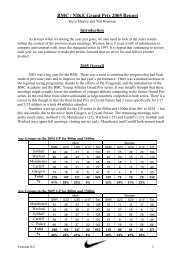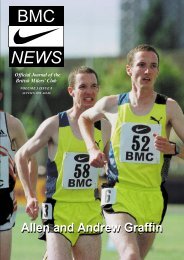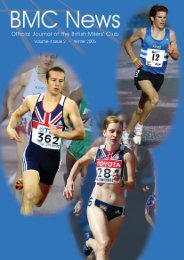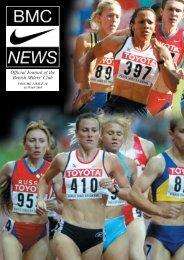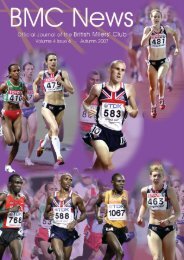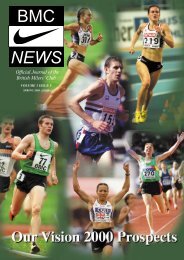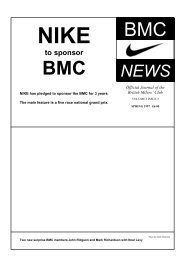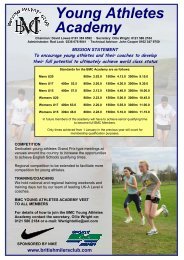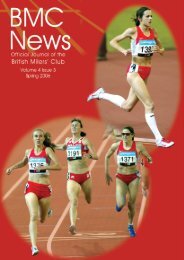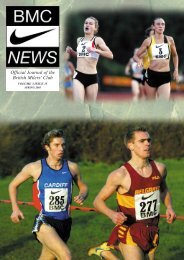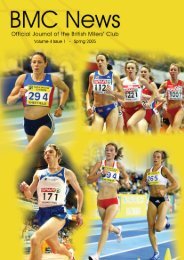BMC April <strong>1999</strong> 6/6/99 9:07 pm Page 32A Standard Format for TrainingFrom 1990 to 1997 Peter Thompson was Project Director of the world wide I.A.A.F Coaches Education andCertification System. In writing and delivering the material for this global programme he was in a privilegedposition to consult with experts from all 208 IAAF Member Federations and to identify and influence common bestpractice. in all track and field disciplines. An example of this can be seen in the area of endurance coaching.One of the factors that has hindered the communication between middle and long distance running and racewalk coaches, and their subsequent communication with athletes, has been a lack of a standardised way torepresent training sessions. Recognising the variety which existed the I.A.A.F introduced in 1997 a standardisedrepresentation of endurance training for its coach education courses and published this in New Studies in Athletics,the technical coaching journal of the I.A.A.F. The BMC News has now adopted the I.A.A.F standard and reprintsit here.Examples of a standard form:10 x 400 (72") [2’]this means: 10 repetitions of 400m , with each repetition run at 72 seconds and 2 minutes recovery between the repetitions.3 x 4 x 300 (51") [1’ & 5’]this means: 3 sets of 4 repetitions of 300m, with each repetition run at 51 seconds, I minute recovery between the repetitionsand 5 minutes between the sets.For more complex sets it may be written, for example:SUMMARYSets x repetitions x distance (intensity/pace) [recovery between reps, then recovery between sets]2 x 500 (300/48", 200/max) [8’] [15’] 8 x 200 (35") [1’]this means: 2 repetitions of 500m, with the first 300m being run at a target pace of 48 seconds and the final 200m being run atmaximal effort. The recovery between the repetitions is 8 minutes. Then there is recovery of 15 minutes, probably easy running,before 8 repetitions of 200m in 35 seconds with one minute recovery.2 x {1 x 500 (80") [2’] 1 x 700 (1’52") [30"] 1 x 300 (max)} [12’]this means: that the athlete will run two sets. Each set will consist of: 1 repetition of 500m in 80 seconds, a recovery of 2minutes, 1 repetition of 700m in 1minute 52 seconds, 30 seconds recovery and then 1 repetition of 300m at maximum effort.There is 12 minutes recovery between the sets.Finally, both the warm up and cool down distances can be included as follows:2 Session Details 2For most <strong>British</strong> coaches this would mean 2 miles warm up and 2 miles cool down but whether these are miles or kilometreswill depend on the understood preference of the coach and athlete.➔➔The above material has been reproduced with the permission of the IAAF and may be photocopied for use in non-profit coaching andeducational settings.©IAAF 199732BMC News : <strong>Spring</strong> <strong>1999</strong>
BMC April <strong>1999</strong> 6/6/99 9:07 pm Page 33The Dunn Testby Lindsay DunnPREDICTING LACTATE THRESHOLDHEART RATESomething which may be of interest to athletesand coaches is a simple practical test I devised formeasuring an athleteÕs lactate threshold pacewithout the use of physiological testing facilitiesbut using a heart rate monitor. The test simplyinvolves two test runs each of 20 minutesconducted in successive weeks.I use a flat, extensive grass area with a goodrunning surface, which has a track in the middle.A road surface, however, with a measured 400mincluded would suffice, provided the area is flatand of an even surface.The athlete does a normal warm up thencommences the 20 minute test run at a pacehe/she believes represents a pace that could bemaintained throughout a half marathon race. Heor she then runs onto the track after 8 minutes ofrunning, at which point the pulse rate should havestabilised and levelled out. The lap time isrecorded along with the pulse reading. Theathlete then returns to running on the grass area.A similar measurement is taken on the trackafter 18 minutes of running. It is emphasised tothe athlete that he/she must endeavour to keep thesame pace and not to run quicker on the tracksince it is not a time trial. Scrutiny of the pulseby Frank HorwillThe oxygen uptake by the tissues of the bodywill increase as running speed increases to amaximum value. This value is known as themaximal oxygen uptake, or VO2 max. Themaximal oxygen uptake is defined as: "thehighest oxygen uptake an individual can attainduring physical work and breathing air at sealevel" and is one of the key determinants ofrunning performance. Pulse rates can be aguide to the percentage of VO2 max being usedwhen expressed as a percentage of yourmaximal pulse rate (MHR). One way ofdiscovering your maximum pulse reading is torun for 3 minutes at maximum effort. Thus, agood class male athlete might attempt running1,200m or more in that time. A female runnershould attempt 1,100m in 3 minutes.The VO2 max is greatly enhanced by trainingbetween 80% and 100% of the VO2 max. Thereadings at other parts of the run can ensure thatthe pace is even throughout.By analysis of the 400m times and pulsereadings I have found that a very accurate interpretationcan be made. For example, if the first400m is 75 seconds and the pulse rate is 170beats per minute (bpm), then the second 400m is77 seconds and pulse 175 bpm you can interpretthat the first 400m was too fast and you nowknow that the lactate threshold is below 170 bpm.On the second test run a week later you set theheart rate monitor alarm to go off if the runnerexceeds 167 bpm. Let us say that this produces400m laps at 8 and 18 minutes of 78 and 79seconds, then 167 is the correct lactate thresholdpulse rate. If it produces 78 seconds on both400m sections then 168 bpm is probably correct.I have found it relatively simple to interpret thereadings allowing an increase in heart rate of 2-3bpm for the second 400m, provided the time isthe same as the first 400m. Armed with thisinformation the athlete can simply do thresholdruns with the alarm set according, without theneed for training partners and regardless ofterrain, conditions, etc.. This is very useful whenthe coach is not present and is of great benefit atappropriate times.Five years ago, the BAF sent a mobile bloodPulse Rate Related to VO2 max percentages% of % of VO2 DescriptionMHR max65 50 Very slow running73 60 Slow running80 70 Steady running88 80 Half marathon speed90 90 10k speed93 95 5k speed96 100 3k speed100 110-130 1,500/800 speedlower the VO2 max percentage work done, thelonger the repetition. For example, work at 90per cent (90% MHR), should last for 10minutes repeated many times with very shortrecovery. The higher the VO2 max workpercentage, the lower the distance of the repetitions,but not too short! For example, 100%VO2 max (96% MHR), 2 to 3 minutes duration,repeated many times in one session withmoderate recovery time. The higher the VO2max an athlete has, the higher the lactatetesting team around the country and I was askedif I wished any of my runners to be tested. Halfof my athletes were tested using increasing paceruns on the track while ear lobe blood sampleswere taken. In three cases, my own calculationsusing the above simple ÔfieldÕ methods wereexact to the same bpm, and for the other twoathletes were 1 bpm out!I find that a lot of runners perceived lactatethreshold effort differs greatly from what itactually is. One case I had was particularly interesting.One of the runners I coached was alwayssuffering from colds and injuries, and I wasMy own calculations using the abovesimple ‘field’methods were exact to thesame bpmalways in dispute with him that his easy runswere too quick. I calculated his lactate thresholdat 168 bpm but he insisted it was nearer 175, as168 felt too easy and some of his supposedly easyruns were 170 bpm or more. The BAF test cameup with 168 bpm!I think that this field test is much easier thanothers I have read about including the Conconione. Perhaps it might be of interest to BMCmembers. I would be happy to have it as the"Dunn Test"!!Pulse rates related to VO2 max percentagesThe VO2 max is greatly enhanced bytraining between 80% and 100% of theVO2 max.threshold, because the latter is a percentage ofthe former.Athletes are warned that heart rates used intraining at race pace, are frequently higher inactual competition from the outset. Strictadherence to training pulse rates in races has ledto athletes being well below their time schedulesfor specific parts of the distance. Compete fortime and place in races. If the aim for a female isa 4:22.5 1,500m, the first lap must not be slowerthan 70 seconds. If the aim is for a 2:00 800m,the first lap must not be more than 60 seconds.Getting the first part of a race right is important.This may involve having to take the lead if thepace is too slow, or even being at the back of thefield if it is too fast. Keep to your time schedule.Astudy of any prevailing wind just before a trackrace is important. It may be necessary to holdback or shelter behind others in a stiff breeze, andto accelerate when the wind is behind you.Athletes should be aware at all times of thepercentage of the VO2 max they are running at.this involves a conmbination of knowing thepercentage of the maximum heart rate used andthe race or training times per 400m.BMC News : <strong>Spring</strong> <strong>1999</strong> 33



